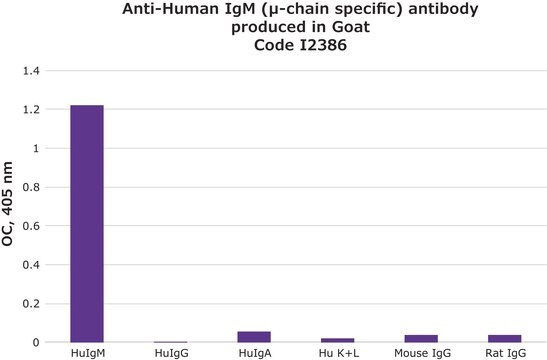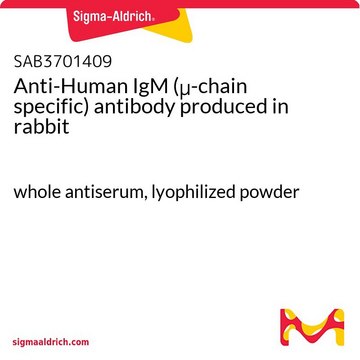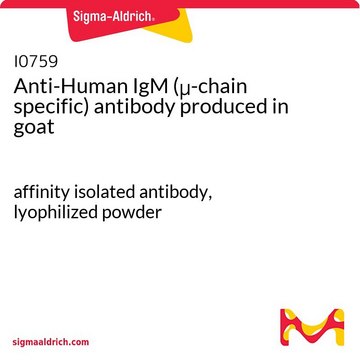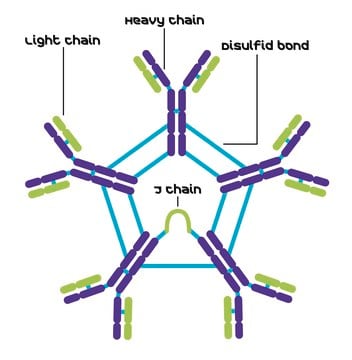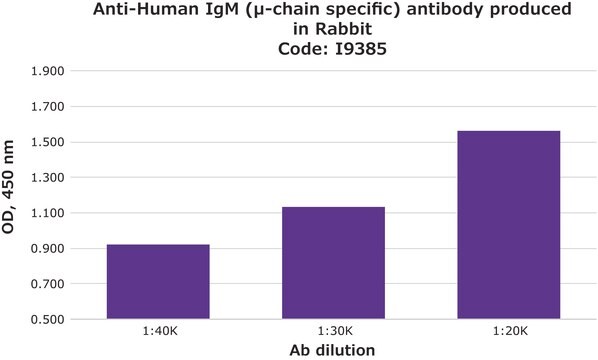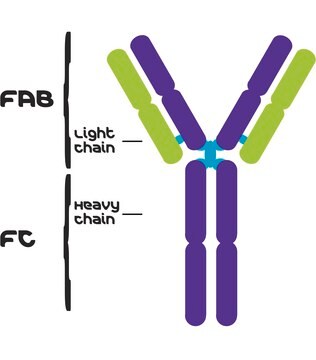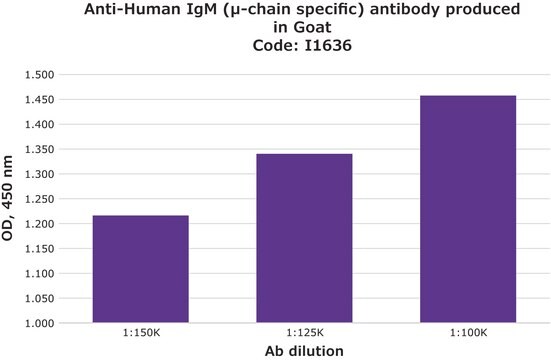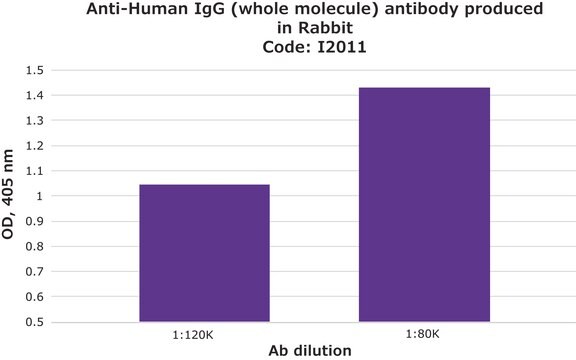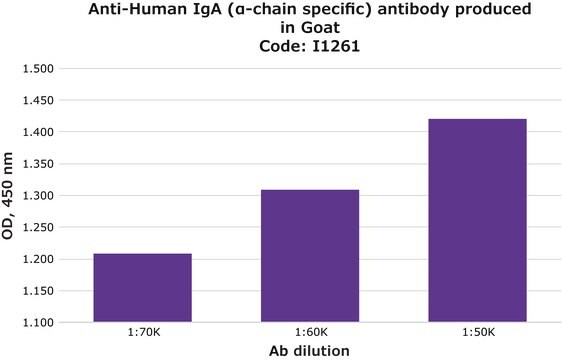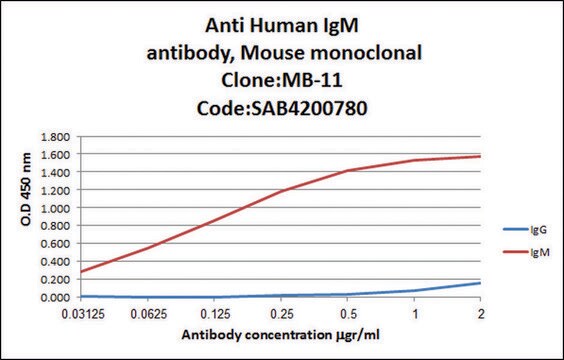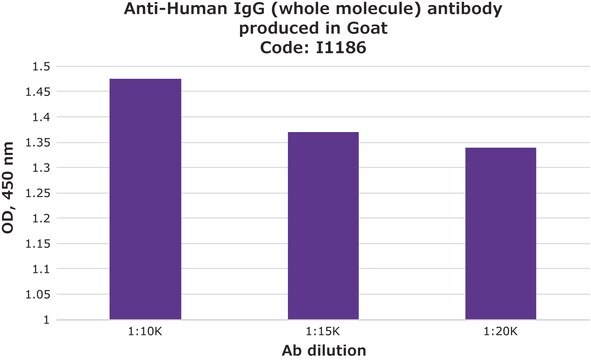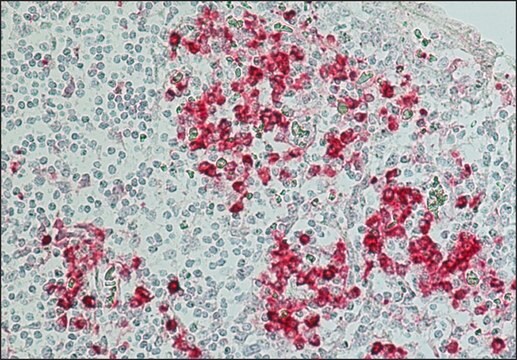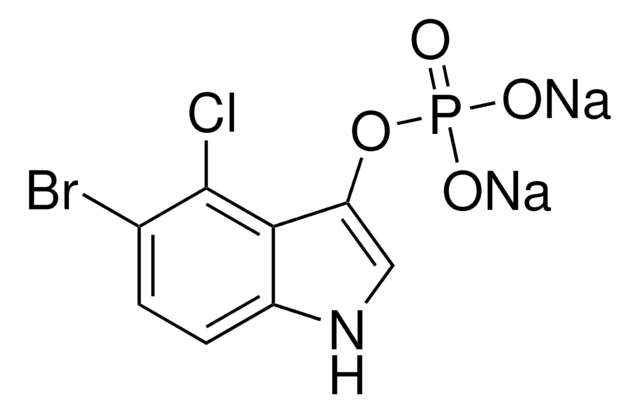I0140
Anti-Human IgM (μ-chain specific) antibody produced in rabbit
IgG fraction of antiserum, buffered aqueous solution
Sign Into View Organizational & Contract Pricing
All Photos(1)
About This Item
Recommended Products
biological source
rabbit
Quality Level
conjugate
unconjugated
antibody form
IgG fraction of antiserum
antibody product type
secondary antibodies
clone
polyclonal
form
buffered aqueous solution
technique(s)
indirect ELISA: 1:100,000
shipped in
dry ice
storage temp.
−20°C
target post-translational modification
unmodified
Looking for similar products? Visit Product Comparison Guide
General description
IgM is a class of antibodies containing a pentamer of five IgG equivalents with 10 Fab fragments, joined by a single cross-linking peptide (J-chain). It constitutes 15% of the normal adult immunoglobulins.
Specificity
The antibody preparation is specific for human IgM when tested against purified human IgA, IgG, IgM, Bence Jones kappa, and lambda myeloma proteins.
Application
Anti-Human IgM (μ-chain specific) antibody produced in rabbit was used as secondary antibody in immunoblotting and indirect ELISA.
Biochem/physiol Actions
IgM antibodies are present as pentamers in the serum and are produced in response to antigens.
Immunoglobulin M (IgM) antibodies appear early in the course of infections. IgM is an initial immunoglobulin produced in the developing fetus as a result of the immune response during the second trimester of pregnancy. It is then substituted by IgG. Therefore, the diagnosis of specific antibodies of the IgM class is useful in detecting chronic infections. IgM is essential for the fetal and neonatal host defense system. IgM cannot cross the placenta. Hence, the presence of IgM might indicate an intrauterine viral infection. IgM antibodies are responsible for the agglutination of red blood cells in mismatched blood transfusions. The level of IgM may vary with the status of disease or infection.
Physical form
Solution in 0.01 M phosphate buffered saline, pH 7.4, containing 15 mM sodium azide as preservative
Storage and Stability
For continuous use, store at 2-8 °C for up to one month. For extended storage, the solution may be frozen in working aliquots at –20 °C. Repeated freezing and thawing, or storage in "frost-free" freezers, is not recommended. If slight turbidity occurs upon prolonged storage, clarify the solution by centrifugation before use.
Disclaimer
Unless otherwise stated in our catalog or other company documentation accompanying the product(s), our products are intended for research use only and are not to be used for any other purpose, which includes but is not limited to, unauthorized commercial uses, in vitro diagnostic uses, ex vivo or in vivo therapeutic uses or any type of consumption or application to humans or animals.
Not finding the right product?
Try our Product Selector Tool.
Storage Class Code
10 - Combustible liquids
WGK
nwg
Flash Point(F)
Not applicable
Flash Point(C)
Not applicable
Choose from one of the most recent versions:
Already Own This Product?
Find documentation for the products that you have recently purchased in the Document Library.
Customers Also Viewed
J Raper et al.
Infection and immunity, 67(4), 1910-1916 (1999-03-20)
Natural resistance of humans to the cattle pathogen Trypanosoma brucei brucei has been attributed to the presence in human serum of nonimmune factors that lyse the parasite. Normal human serum contains two trypanosome lytic factors (TLFs). TLF1 is a 500-kDa
E J Wiersma et al.
Journal of immunology (Baltimore, Md. : 1950), 160(12), 5979-5989 (1998-06-24)
Previous studies have discerned two forms of polymeric mouse IgM: moderately cytolytic (complement-activating) pentamer, which contains J chain, and highly cytolytic hexamer, which lacks J chain. To investigate the relationships among polymeric structure, J chain content, and cytolytic activity, we
Our team of scientists has experience in all areas of research including Life Science, Material Science, Chemical Synthesis, Chromatography, Analytical and many others.
Contact Technical Service